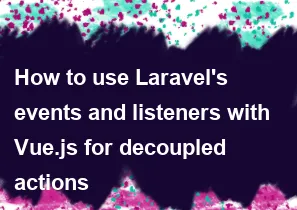How to use Laravel's events and listeners with Vue.js for decoupled actions

Laravel's events and listeners can be used to create a decoupled system where certain actions in your Laravel backend trigger events, and those events can be listened to by various listeners. Integrating Vue.js with Laravel events and listeners allows you to update your frontend in response to backend events without tightly coupling the two.
Here's a step-by-step guide on how you can achieve this:
1. Set up Laravel Event and Listener:
Create an event using the following artisan command:
bashphp artisan make:event YourEventName
Define the event properties and any necessary logic in the created event file.
Create a listener using the following artisan command:
bashphp artisan make:listener YourListenerName --event=YourEventName
In the created listener, handle the event and perform any necessary actions.
2. Fire the Event in Laravel Controller:
In your Laravel controller, fire the event when the relevant action occurs. For example:
phppublic function someAction()
{
// Perform some actions
// Fire the event
event(new YourEventName($data));
// Return response
return response()->json(['message' => 'Action completed']);
}
3. Set Up Vue.js to Listen to Events:
Use Laravel Echo and Pusher to listen for events in your Vue.js components.
Install Laravel Echo and Pusher:
bashnpm install --save laravel-echo pusher-js
Set Up Laravel Echo in Your Vue.js Component:
javascript// resources/js/bootstrap.js
import Echo from 'laravel-echo';
window.Pusher = require('pusher-js');
window.Echo = new Echo({
broadcaster: 'pusher',
key: process.env.MIX_PUSHER_APP_KEY,
cluster: process.env.MIX_PUSHER_APP_CLUSTER,
encrypted: true,
});
Make sure to configure your Pusher credentials in your .env file.
Listen for the Event in Your Vue.js Component:
javascript// YourVueComponent.vue
export default {
mounted() {
// Listen for the event
window.Echo.channel('your-channel-name')
.listen('YourEventName', (event) => {
// Handle the event data and update your Vue component
console.log('Event received:', event);
});
},
};
4. Broadcast the Event:
Make sure that broadcasting is set up in your Laravel application. You can use Laravel Echo and Pusher or other broadcasting options supported by Laravel.
Update Broadcasting Configuration:
In your config/broadcasting.php file, make sure the default driver is set to 'pusher' or the driver you are using.
5. Test the Integration:
Test the integration by triggering the action in your Laravel controller and observing the updates in your Vue.js component.
This decoupled approach allows your frontend and backend to evolve independently, making your application more maintainable and scalable.
-
Popular Post
- How to optimize for Google's About This Result feature for local businesses
- How to implement multi-language support in an Express.js application
- How to handle and optimize for changes in mobile search behavior
- How to handle CORS in a Node.js application
- How to use Vue.js with a UI framework (e.g., Vuetify, Element UI)
- How to configure Laravel Telescope for monitoring and profiling API requests
- How to create a command-line tool using the Commander.js library in Node.js
- How to implement code splitting in a React.js application
- How to use the AWS SDK for Node.js to interact with various AWS services
- How to use the Node.js Stream API for efficient data processing
- How to implement a cookie parser middleware in Node.js
- How to implement WebSockets for real-time communication in React
-
Latest Post
- How to implement a dynamic form with dynamic field styling based on user input in Next.js
- How to create a custom hook for handling user interactions with the browser's device motion in Next.js
- How to create a custom hook for handling user interactions with the browser's battery status in Next.js
- How to implement a dynamic form with dynamic field visibility based on user input in Next.js
- How to implement a dynamic form with real-time collaboration features in Next.js
- How to create a custom hook for handling user interactions with the browser's media devices in Next.js
- How to use the useSWRInfinite hook for paginating data with a custom loading indicator in Next.js
- How to create a custom hook for handling user interactions with the browser's network status in Next.js
- How to create a custom hook for handling user interactions with the browser's location in Next.js
- How to implement a dynamic form with multi-language support in Next.js
- How to create a custom hook for handling user interactions with the browser's ambient light sensor in Next.js
- How to use the useHover hook for creating interactive image zoom effects in Next.js